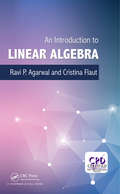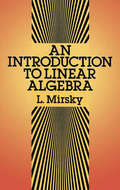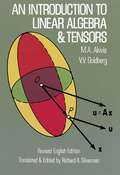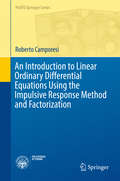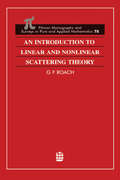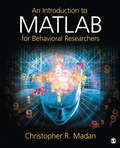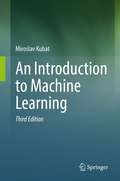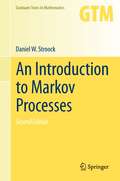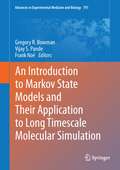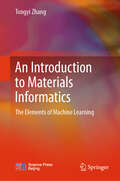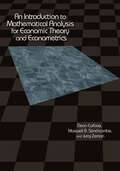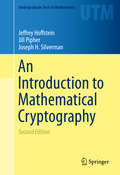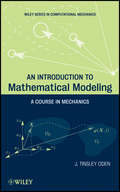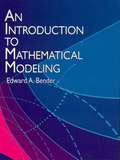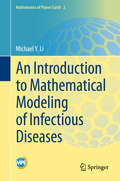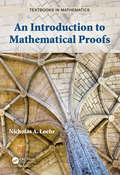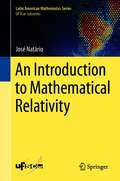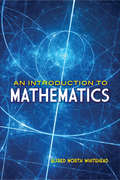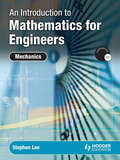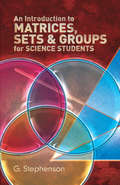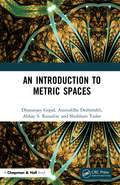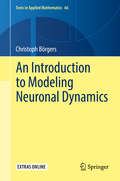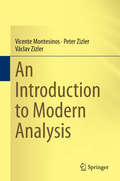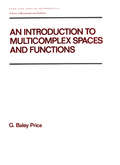- Table View
- List View
An Introduction to Linear Algebra
by Ravi P. Agarwal Elena Cristina FlautThe techniques of linear algebra are used extensively across the applied sciences, and in many different areas of algebra such as group theory, module theory, representation theory, ring theory, and Galois theory. Written by experienced researchers with a decades of teaching experience, Introduction to Linear Algebra is a clear and rigorous introductory text on this key topic for students of both applied sciences and pure mathematics.
An Introduction to Linear Algebra (Dover Books on Mathematics)
by L. MirskyThis work provides an elementary and easily readable account of linear algebra, in which the exposition is sufficiently simple to make it equally useful to readers whose principal interests lie in the fields of physics or technology. The account is self-contained, and the reader is not assumed to have any previous knowledge of linear algebra. Although its accessibility makes it suitable for non-mathematicians, Professor Mirsky's book is nevertheless a systematic and rigorous development of the subject. Part I deals with determinants, vector spaces, matrices, linear equations, and the representation of linear operators by matrices. Part II begins with the introduction of the characteristic equation and goes on to discuss unitary matrices, linear groups, functions of matrices, and diagonal and triangular canonical forms. Part II is concerned with quadratic forms and related concepts. Applications to geometry are stressed throughout; and such topics as rotation, reduction of quadrics to principal axes, and classification of quadrics are treated in some detail. An account of most of the elementary inequalities arising in the theory of matrices is also included. Among the most valuable features of the book are the numerous examples and problems at the end of each chapter, carefully selected to clarify points made in the text.
An Introduction to Linear Algebra and Tensors (Dover Books on Mathematics)
by Richard A. Silverman M. A. Akivis V. V. GoldbergThe present book, a valuable addition to the English-language literature on linear algebra and tensors, constitutes a lucid, eminently readable and completely elementary introduction to this field of mathematics. A special merit of the book is its free use of tensor notation, in particular the Einstein summation convention. The treatment is virtually self-contained. In fact, the mathematical background assumed on the part of the reader hardly exceeds a smattering of calculus and a casual acquaintance with determinants.The authors begin with linear spaces, starting with basic concepts and ending with topics in analytic geometry. They then treat multilinear forms and tensors (linear and bilinear forms, general definition of a tensor, algebraic operations on tensors, symmetric and antisymmetric tensors, etc.), and linear transformation (again basic concepts, the matrix and multiplication of linear transformations, inverse transformations and matrices, groups and subgroups, etc.). The last chapter deals with further topics in the field: eigenvectors and eigenvalues, matrix ploynomials and the Hamilton-Cayley theorem, reduction of a quadratic form to canonical form, representation of a nonsingular transformation, and more. Each individual section -- there are 25 in all -- contains a problem set, making a total of over 250 problems, all carefully selected and matched. Hints and answers to most of the problems can be found at the end of the book.Dr. Silverman has revised the text and numerous pedagogical and mathematical improvements, and restyled the language so that it is even more readable. With its clear exposition, many relevant and interesting problems, ample illustrations, index and bibliography, this book will be useful in the classroom or for self-study as an excellent introduction to the important subjects of linear algebra and tensors.
An Introduction to Linear Ordinary Differential Equations Using the Impulsive Response Method and Factorization (PoliTO Springer Series)
by Roberto CamporesiThis book presents a method for solving linear ordinary differential equations based on the factorization of the differential operator. The approach for the case of constant coefficients is elementary, and only requires a basic knowledge of calculus and linear algebra. In particular, the book avoids the use of distribution theory, as well as the other more advanced approaches: Laplace transform, linear systems, the general theory of linear equations with variable coefficients and variation of parameters. The case of variable coefficients is addressed using Mammana's result for the factorization of a real linear ordinary differential operator into a product of first-order (complex) factors, as well as a recent generalization of this result to the case of complex-valued coefficients.
An Introduction to Linear and Nonlinear Scattering Theory (Monographs And Surveys In Pure And Applied Math #78)
by G F RoachThis monograph has two main purposes, first to act as a companion volume to more advanced texts by gathering together the principal mathematical topics commonly used in developing scattering theories and, in so doing, provide a reasonable, self-contained introduction to linear and nonlinear scattering theory for those who might wish to begin working in the area. Secondly, to indicate how these various aspects might be applied to problems in mathematical physics and the applied sciences. Of particular interest will be the influence of boundary conditions.
An Introduction to MATLAB for Behavioral Researchers
by Christopher R. MadanMATLAB is a powerful data analysis program, but many behavioral science researchers find it too daunting to learn and use. An Introduction to MATLAB for Behavioral Researchers by Christopher R. Madan is an easy-to-understand, hands-on guide for behavioral researchers who have no prior programming experience. Written in a conversational and non-intimidating style, the author walks students—step by step—through analyzing real experimental data. Topics covered include the basics of programming, the implementation of simple behavioral analyses, and how to make publication-ready figures. More advanced topics such as pseudo-randomization of trial sequences to meet specified criteria and working with psycholinguistic data are also covered. Interesting behavioral science examples and datasets from published studies, such as visualizing fixation patterns in eye-tracking studies and animal search behavior in two-dimensional space, help develop an intuition for data analysis, which is essential and can only be developed when working with real research problems and real data.
An Introduction to Machine Learning
by Miroslav KubatThis textbook offers a comprehensive introduction to Machine Learning techniques and algorithms. This Third Edition covers newer approaches that have become highly topical, including deep learning, and auto-encoding, introductory information about temporal learning and hidden Markov models, and a much more detailed treatment of reinforcement learning. The book is written in an easy-to-understand manner with many examples and pictures, and with a lot of practical advice and discussions of simple applications. The main topics include Bayesian classifiers, nearest-neighbor classifiers, linear and polynomial classifiers, decision trees, rule-induction programs, artificial neural networks, support vector machines, boosting algorithms, unsupervised learning (including Kohonen networks and auto-encoding), deep learning, reinforcement learning, temporal learning (including long short-term memory), hidden Markov models, and the genetic algorithm. Special attention is devoted to performance evaluation, statistical assessment, and to many practical issues ranging from feature selection and feature construction to bias, context, multi-label domains, and the problem of imbalanced classes.
An Introduction to Markov Processes (Graduate Texts in Mathematics #230)
by Daniel W. StroockThis book provides a rigorous but elementary introduction to the theory of Markov Processes on a countable state space. It should be accessible to students with a solid undergraduate background in mathematics, including students from engineering, economics, physics, and biology. Topics covered are: Doeblin's theory, general ergodic properties, and continuous time processes. Applications are dispersed throughout the book. In addition, a whole chapter is devoted to reversible processes and the use of their associated Dirichlet forms to estimate the rate of convergence to equilibrium. These results are then applied to the analysis of the Metropolis (a. k. a simulated annealing) algorithm. The corrected and enlarged 2nd edition contains a new chapter in which the author develops computational methods for Markov chains on a finite state space. Most intriguing is the section with a new technique for computing stationary measures, which is applied to derivations of Wilson's algorithm and Kirchoff's formula for spanning trees in a connected graph.
An Introduction to Markov State Models and Their Application to Long Timescale Molecular Simulation (Advances in Experimental Medicine and Biology #797)
by Gregory R. Bowman Vijay S. Pande Frank NoéThe aim of this book volume is to explain the importance of Markov state models to molecular simulation, how they work, and how they can be applied to a range of problems. The Markov state model (MSM) approach aims to address two key challenges of molecular simulation: 1) How to reach long timescales using short simulations of detailed molecular models. 2) How to systematically gain insight from the resulting sea of data. MSMs do this by providing a compact representation of the vast conformational space available to biomolecules by decomposing it into states sets of rapidly interconverting conformations and the rates of transitioning between states. This kinetic definition allows one to easily vary the temporal and spatial resolution of an MSM from high-resolution models capable of quantitative agreement with (or prediction of) experiment to low-resolution models that facilitate understanding. Additionally, MSMs facilitate the calculation of quantities that are difficult to obtain from more direct MD analyses, such as the ensemble of transition pathways. This book introduces the mathematical foundations of Markov models, how they can be used to analyze simulations and drive efficient simulations, and some of the insights these models have yielded in a variety of applications of molecular simulation.
An Introduction to Materials Informatics: The Elements of Machine Learning
by Tongyi ZhangThis textbook educates current and future materials workers, engineers, and researchers on Materials Informatics. Volume I serves as an introduction, merging AI, ML, materials science, and engineering. It covers essential topics and algorithms in 11 chapters, including Linear Regression, Neural Networks, and more. Suitable for diverse fields like materials science, physics, and chemistry, it enables quick and easy learning of Materials Informatics for readers without prior AI and ML knowledge.
An Introduction to Mathematical Analysis for Economic Theory and Econometrics
by Juraj Zeman Dean Corbae Maxwell StinchcombeProviding an introduction to mathematical analysis as it applies to economic theory and econometrics, this book bridges the gap that has separated the teaching of basic mathematics for economics and the increasingly advanced mathematics demanded in economics research today. Dean Corbae, Maxwell B. Stinchcombe, and Juraj Zeman equip students with the knowledge of real and functional analysis and measure theory they need to read and do research in economic and econometric theory. Unlike other mathematics textbooks for economics, An Introduction to Mathematical Analysis for Economic Theory and Econometrics takes a unified approach to understanding basic and advanced spaces through the application of the Metric Completion Theorem. This is the concept by which, for example, the real numbers complete the rational numbers and measure spaces complete fields of measurable sets. Another of the book's unique features is its concentration on the mathematical foundations of econometrics. To illustrate difficult concepts, the authors use simple examples drawn from economic theory and econometrics. Accessible and rigorous, the book is self-contained, providing proofs of theorems and assuming only an undergraduate background in calculus and linear algebra. Begins with mathematical analysis and economic examples accessible to advanced undergraduates in order to build intuition for more complex analysis used by graduate students and researchers Takes a unified approach to understanding basic and advanced spaces of numbers through application of the Metric Completion Theorem Focuses on examples from econometrics to explain topics in measure theory
An Introduction to Mathematical Cryptography (Undergraduate Texts in Mathematics)
by Joseph H. Silverman Jeffrey Hoffstein Jill PipherThis self-contained introduction to modern cryptography emphasizes the mathematics behind the theory of public key cryptosystems and digital signature schemes. The book focuses on these key topics while developing the mathematical tools needed for the construction and security analysis of diverse cryptosystems. Only basic linear algebra is required of the reader; techniques from algebra, number theory, and probability are introduced and developed as required. This text provides an ideal introduction for mathematics and computer science students to the mathematical foundations of modern cryptography. The book includes an extensive bibliography and index; supplementary materials are available online. The book covers a variety of topics that are considered central to mathematical cryptography. Key topics include: classical cryptographic constructions, such as Diffie-Hellmann key exchange, discrete logarithm-based cryptosystems, the RSA cryptosystem, and digital signatures; fundamental mathematical tools for cryptography, including primality testing, factorization algorithms, probability theory, information theory, and collision algorithms; an in-depth treatment of important cryptographic innovations, such as elliptic curves, elliptic curve and pairing-based cryptography, lattices, lattice-based cryptography, and the NTRU cryptosystem. The second edition of An Introduction to Mathematical Cryptography includes a significant revision of the material on digital signatures, including an earlier introduction to RSA, Elgamal, and DSA signatures, and new material on lattice-based signatures and rejection sampling. Many sections have been rewritten or expanded for clarity, especially in the chapters on information theory, elliptic curves, and lattices, and the chapter of additional topics has been expanded to include sections on digital cash and homomorphic encryption. Numerous new exercises have been included.
An Introduction to Mathematical Modeling
by J. Tinsley OdenA modern approach to mathematical modeling, featuring unique applications from the field of mechanics An Introduction to Mathematical Modeling: A Course in Mechanics is designed to survey the mathematical models that form the foundations of modern science and incorporates examples that illustrate how the most successful models arise from basic principles in modern and classical mathematical physics. Written by a world authority on mathematical theory and computational mechanics, the book presents an account of continuum mechanics, electromagnetic field theory, quantum mechanics, and statistical mechanics for readers with varied backgrounds in engineering, computer science, mathematics, and physics. The author streamlines a comprehensive understanding of the topic in three clearly organized sections: Nonlinear Continuum Mechanics introduces kinematics as well as force and stress in deformable bodies; mass and momentum; balance of linear and angular momentum; conservation of energy; and constitutive equations Electromagnetic Field Theory and Quantum Mechanics contains a brief account of electromagnetic wave theory and Maxwell's equations as well as an introductory account of quantum mechanics with related topics including ab initio methods and Spin and Pauli's principles Statistical Mechanics presents an introduction to statistical mechanics of systems in thermodynamic equilibrium as well as continuum mechanics, quantum mechanics, and molecular dynamics Each part of the book concludes with exercise sets that allow readers to test their understanding of the presented material. Key theorems and fundamental equations are highlighted throughout, and an extensive bibliography outlines resources for further study. Extensively class-tested to ensure an accessible presentation, An Introduction to Mathematical Modeling is an excellent book for courses on introductory mathematical modeling and statistical mechanics at the upper-undergraduate and graduate levels. The book also serves as a valuable reference for professionals working in the areas of modeling and simulation, physics, and computational engineering.
An Introduction to Mathematical Modeling (Dover Books on Computer Science)
by Edward A. BenderEmploying a practical, "learn by doing" approach, this first-rate text fosters the development of the skills beyond the pure mathematics needed to set up and manipulate mathematical models. The author draws on a diversity of fields -- including science, engineering, and operations research -- to provide over 100 reality-based examples. Students learn from the examples by applying mathematical methods to formulate, analyze, and criticize models. Extensive documentation, consisting of over 150 references, supplements the models, encouraging further research on models of particular interest. The lively and accessible text requires only minimal scientific background. Designed for senior college or beginning graduate-level students, it assumes only elementary calculus and basic probability theory for the first part, and ordinary differential equations and continuous probability for the second section. All problems require students to study and create models, encouraging their active participation rather than a mechanical approach. Beyond the classroom, this volume will prove interesting and rewarding to anyone concerned with the development of mathematical models or the application of modeling to problem solving in a wide array of applications.
An Introduction to Mathematical Modeling of Infectious Diseases (Mathematics of Planet Earth #2)
by Michael Y. LiThis text provides essential modeling skills and methodology for the study of infectious diseases through a one-semester modeling course or directed individual studies. The book includes mathematical descriptions of epidemiological concepts, and uses classic epidemic models to introduce different mathematical methods in model analysis. Matlab codes are also included for numerical implementations. It is primarily written for upper undergraduate and beginning graduate students in mathematical sciences who have an interest in mathematical modeling of infectious diseases. Although written in a rigorous mathematical manner, the style is not unfriendly to non-mathematicians.
An Introduction to Mathematical Proofs (Textbooks in Mathematics)
by Nicholas A. LoehrAn Introduction to Mathematical Proofs presents fundamental material on logic, proof methods, set theory, number theory, relations, functions, cardinality, and the real number system. The text uses a methodical, detailed, and highly structured approach to proof techniques and related topics. No prerequisites are needed beyond high-school algebra. New material is presented in small chunks that are easy for beginners to digest. The author offers a friendly style without sacrificing mathematical rigor. Ideas are developed through motivating examples, precise definitions, carefully stated theorems, clear proofs, and a continual review of preceding topics. Features Study aids including section summaries and over 1100 exercises Careful coverage of individual proof-writing skills Proof annotations and structural outlines clarify tricky steps in proofs Thorough treatment of multiple quantifiers and their role in proofs Unified explanation of recursive definitions and induction proofs, with applications to greatest common divisors and prime factorizations About the Author: Nicholas A. Loehr is an associate professor of mathematics at Virginia Technical University. He has taught at College of William and Mary, United States Naval Academy, and University of Pennsylvania. He has won many teaching awards at three different schools. He has published over 50 journal articles. He also authored three other books for CRC Press, including Combinatorics, Second Edition, and Advanced Linear Algebra.
An Introduction to Mathematical Reasoning
by Peter J. EcclesThis book eases students into the rigors of university mathematics. The emphasis is on understanding and constructing proofs and writing clear mathematics. The author achieves this by exploring set theory, combinatorics, and number theory, topics that include many fundamental ideas and may not be a part of a young mathematician's toolkit. This material illustrates how familiar ideas can be formulated rigorously, provides examples demonstrating a wide range of basic methods of proof, and includes some of the all-time-great classic proofs. The book presents mathematics as a continually developing subject. Material meeting the needs of readers from a wide range of backgrounds is included. The over 250 problems include questions to interest and challenge the most able student but also plenty of routine exercises to help familiarize the reader with the basic ideas.
An Introduction to Mathematical Relativity (Latin American Mathematics Series)
by José NatárioThis concise textbook introduces the reader to advanced mathematical aspects of general relativity, covering topics like Penrose diagrams, causality theory, singularity theorems, the Cauchy problem for the Einstein equations, the positive mass theorem, and the laws of black hole thermodynamics. It emerged from lecture notes originally conceived for a one-semester course in Mathematical Relativity which has been taught at the Instituto Superior Técnico (University of Lisbon, Portugal) since 2010 to Masters and Doctorate students in Mathematics and Physics. Mostly self-contained, and mathematically rigorous, this book can be appealing to graduate students in Mathematics or Physics seeking specialization in general relativity, geometry or partial differential equations. Prerequisites include proficiency in differential geometry and the basic principles of relativity. Readers who are familiar with special relativity and have taken a course either in Riemannian geometry (for students of Mathematics) or in general relativity (for those in Physics) can benefit from this book.
An Introduction to Mathematics (Dover Books on Mathematics)
by Alfred North Whitehead"The object of the following chapters is not to teach mathematics, but to enable students from the very beginning of their course to know what the science is about, and why it is necessarily the foundation of exact thought as applied to natural phenomena." Thus begins this volume by the prominent English philosopher and mathematician Alfred North Whitehead, a concise statement on the nature and meaning of mathematics for the general student. Expertly written and abounding in insights, the book presents a lively exposition of mathematical concepts, the history of their development, and their applications to the physical world. Whitehead explains in broad terms what mathematics is about, what it does, and how mathematicians do it.Generations of readers who have stayed with the philosopher from the beginning to the end have found themselves amply rewarded for taking this journey.
An Introduction to Mathematics for Engineers: Mechanics
by Stephen LeeThis new introductory mechanics textbook is written for engineering students within further and higher education who are looking to bridge the gap between A-Level and university or college.
An Introduction to Matrices, Sets and Groups for Science Students
by G. StephensonThis outstanding text offers undergraduate students of physics, chemistry, and engineering a concise, readable introduction to matrices, sets, and groups. Concentrating mainly on matrix theory, the book is virtually self-contained, requiring a minimum of mathematical knowledge and providing all the background necessary to develop a thorough comprehension of the subject. Beginning with a chapter on sets, mappings, and transformations, the treatment advances to considerations of matrix algebra, inverse and related matrices, and systems of linear algebraic equations. Additional topics include eigenvalues and eigenvectors, diagonalisation and functions of matrices, and group theory. Each chapter contains a selection of worked examples and many problems with answers, enabling readers to test their understanding and ability to apply concepts.
An Introduction to Metric Spaces
by Dhananjay Gopal Aniruddha Deshmukh Abhay S Ranadive Shubham YadavThis book serves as a textbook for an introductory course in metric spaces for undergraduate or graduate students. The goal is to present the basics of metric spaces in a natural and intuitive way and encourage students to think geometrically while actively participating in the learning of this subject. In this book, the authors illustrated the strategy of the proofs of various theorems that motivate readers to complete them on their own. Bits of pertinent history are infused in the text, including brief biographies of some of the central players in the development of metric spaces. The textbook is divided into seven chapters that contain the main materials on metric spaces; namely, introductory concepts, completeness, compactness, connectedness, continuous functions and metric fixed point theorems with applications. Some of the noteworthy features of this book include · Diagrammatic illustrations that encourage readers to think geometrically · Focus on systematic strategy to generate ideas for the proofs of theorems · A wealth of remarks, observations along with a variety of exercises · Historical notes and brief biographies appearing throughout the text
An Introduction to Modeling Neuronal Dynamics
by Christoph BörgersThis book is intended as a text for a one-semester course on Mathematical and Computational Neuroscience for upper-level undergraduate and beginning graduate students of mathematics, the natural sciences, engineering, or computer science. An undergraduate introduction to differential equations is more than enough mathematical background. Only a slim, high school-level background in physics is assumed, and none in biology. Topics include models of individual nerve cells and their dynamics, models of networks of neurons coupled by synapses and gap junctions, origins and functions of population rhythms in neuronal networks, and models of synaptic plasticity.An extensive online collection of Matlab programs generating the figures accompanies the book.
An Introduction to Modern Analysis
by Vicente Montesinos Václav Zizler Peter ZizlerExamining the basic principles in real analysis and their applications, this text provides a self-contained resource for graduate and advanced undergraduate courses. It contains independent chapters aimed at various fields of application, enhanced by highly advanced graphics and results explained and supplemented with practical and theoretical exercises. The presentation of the book is meant to provide natural connections to classical fields of applications such as Fourier analysis or statistics. However, the book also covers modern areas of research, including new and seminal results in the area of functional analysis.
An Introduction to Multicomplex SPates and Functions (Chapman And Hall/crc Pure And Applied Mathematics Ser. #140)
by PriceA rather pretty little book, written in the form of a text but more likely to be read simply for pleasure, in which the author (Professor Emeritus of Mathematics at the U. of Kansas) explores the analog of the theory of functions of a complex variable which comes into being when the complexes are re
